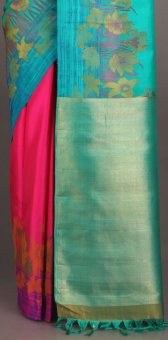Arni Silk Saree
Background

Arni is a town situated in Thiruvannamalai District in Tamil Nadu. Traditionally, Arni silk sarees are called as “Dobby variety”.
These sarees are woven with mulberry silk in warp and weft by using dobby. The border has thin line of Zari and or small designs.
These sarees are lighter than Kancheepuram saree and weigh about 300 - 400 gram.
These are woven either with one side border or both side borders, but without interlocking the body and the border as done in Kancheepuram saree.
These are woven either with single warp or double warp and single weft or multiply weft. These sarees are used mostly in wedding and other important functions of the family.
Material used
The materials used for the production of Arni silk sarees are mulberry silk, pure gold zari or half fine (imitation) zari. The count of warp and weft is 18/20 – 20/22 (2ply) Den mulberry silk. Nowadays, heavier Arni silk sarees are also being woven using 18/20 – 20/22D (4ply) Den silk in warp and 18/20 – 20/24 (8ply) Den silk in weft.
Technique applied
Arni silk sarees are produced with dobby for small motif in border. Nowadays, two to three jacquards with capacity 120-240 Hooks are also used to produce complex designs in the border, body and pallu. Sarees are woven in throw shuttle pit and frame loom fitted with dobby or jacquard.
How to distinguish genuine Arni Silk Saree
- Pure silk saree with small zari border and less complicated design in the pallu.
- Lighter than Kancheepuram Silk saree but heavier than Benarasi Silk Saree.
- No solid or contrast coloured border as found in Kancheepuram Saree.
- No extra series of warp threads in pallu.
Source : Indian Handloom Brand
Last Modified : 9/17/2023
This topic provides information about Tussar Gichh...
This topic provides information about Pochhampally...
This topic provides information about Tweed.
This topic provides information about Uppada Jamda...
